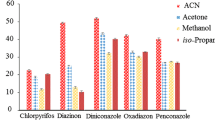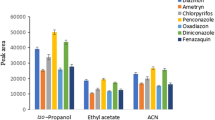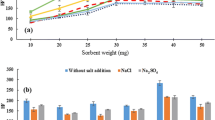Abstract
In this study, a simple and reliable sample preparation method based on an efficient version of homogeneous liquid-liquid extraction combined with dispersive liquid-liquid microextraction solidification of floating organic drop has been introduced to analyze some pesticide residues in fruit and fruit juice samples with gas chromatography-flame ionization detection. Under the optimum experimental conditions, limits of detection and quantification were in the ranges of 0.20–0.60 and 0.66–2.0 μg L−1, respectively. The repeatability of the method was good and the relative standard deviations were less than 7 % for intra- (n = 6) and inter-day (n = 4) precisions at a concentration of 50 μg L−1 of each analyte. High enrichment factors (3265–3728) and extraction recoveries (82–93 %) were obtained. Finally, the method was applied for determination of pesticides in the selected samples and chlorpyrifos was found in strawberry at ng g−1 concentration. Furthermore, no filtration was used in the cases of the fruit samples.








Similar content being viewed by others
Abbreviations
- DLLME:
-
Dispersive liquid-liquid microextraction
- EF:
-
Enrichment factor
- ER:
-
Extraction recovery
- FID:
-
Flame ionization detection
- GC:
-
Gas chromatography
- HLLE:
-
Homogeneous liquid-liquid extraction
- LLE:
-
Liquid-liquid extraction
- LOD:
-
Limit of detection
- LPME:
-
Liquid-phase microextraction
- LOQ:
-
Limit of quantification
- MS:
-
Mass spectrometry
- RSD:
-
Relative standard deviation
- SFO:
-
Solidification of floating organic drop
- SPE:
-
Solid-phase extraction
References
Amini T, Hashemi P (2018) Preconcentration and GC–MS determination of caffeine in tea and coffee using homogeneous liquid–liquid microextraction based on solvents volume ratio alteration. J Chromatogr B 1092:252–257
Anthemidis AN, Adam IS (2009) Development of on-line single-drop micro-extraction sequential injection system for electrothermal atomic absorption spectrometric determination of trace metals. Anal Chim Acta 632:216–220
Chen H, Chen R, Li S (2010) Low-density extraction solvent-based solvent terminated dispersive liquid–liquid microextraction combined with gas chromatography-tandem mass spectrometry for the determination of carbamate pesticides in water samples. J Chromatogr A 1217:1244–1248
Costa LG, Giordano G, Guizzetti M, Vitalone A (2008) Neurotoxicity of pesticides: a brief review. Front Biosci 13:1240–1249
Djozan D, Assadi Y (2004) Modified pencil lead as a new fiber for solid-phase microextraction. Chromatographia 60:313–317
Ebrahimzadeh H, Yamini Y, Kamarei F, Shariati S (2007) Homogeneous liquid–liquid extraction of trace amounts of mononitrotoluenes from waste water samples. Anal Chim Acta 594:93–100
Fang G, Chen W, Yao Y, Wang J, Qin J, Wang S (2012) Multi-residue determination of organophosphorus and organochlorine pesticides in environmental samples using solid-phase extraction with cigarette filter followed by gas chromatography–mass spectrometry. J Sep Sci 35:534–540
Farajzadeh MA, Mogaddam MRA, Aghdam SR, Nouri N, Bamorrowat M (2016) Application of elevated temperature-dispersive liquid-liquid microextraction for determination of organophosphorus pesticides residues in aqueous samples followed by gas chromatography-flame ionization detection. Food Chem 212:198–204
Farajzadeh MA, Alavian AS, Dabbagh MS (2018) Application of vortex-assisted liquid–liquid microextraction based on solidification of floating organic droplets for determination of some pesticides in fruit juice samples. Anal Methods 10:5842–5850
Gao Z, Ma X (2011) Speciation analysis of mercury in water samples using dispersive liquid–liquid microextraction combined with high-performance liquid chromatography. Anal Chim Acta 702:50–55
Gao Y, Sun P (2018) Determination of five pyrethroid pesticides residue in liquid milk by gas chromatography using multi-walled carbon nanotubes as dispersion solid phase extraction sorbent. Acta Chromatogr 30:141–146
Ghiasvand A, Shadabi S, Mohagheghzadeh E, Hashemi P (2005) Homogeneous liquid–liquid extraction method for the selective separation and preconcentration of ultra trace molybdenum. Talanta 66:912–916
Khalili-Zanjani MR, Yamini Y, Yazdanfar N, Shariati S (2008) Extraction and determination of organophosphorus pesticides in water samples by a new liquid phase microextraction–gas chromatography–flame photometric detection. Anal Chim Acta 606:202–208
Khan DA, Bhatti MM, Khan FA, Naqvi ST, Karam A (2008) Adverse effects of pesticides residues on biochemical markers in Pakistani tobacco farmers. Int J Clin Exp Med 1:274
Kokosa JM, Przyjazny A, Jeannot M (2009) Solvent microextraction: theory and practice. John Wiley & Sons
Li S, Gao P, Zhang J, Li Y, Peng B, Gao H, Zhou W (2012) Sequential dispersive liquid–liquid microextraction for the determination of aryloxyphenoxy-propionate herbicides in water. J Sep Sci 35:3389–3395
Miró M, Estela JM, Cerdà V (2005) Recent advances in on-line solvent extraction exploiting flow injection/sequential injection analysis. Curr Anal Chem 1:329–343
Murata K, Yokoyama Y, Ikeda S (1972) Homogeneous liquid-liquid extraction method. Extraction of iron (III) thenoyltrifluoroacetonate by propylene carbonate. Anal Chem 44:805–810
Nieto A, Borrull F, Pocurull E, Marcé RM (2010) Pressurized liquid extraction: a useful technique to extract pharmaceuticals and personal-care products from sewage sludge. TrAC Trends Anal Chem 29:752–764
Ojeda CB, Rojas FS (2009) Separation and preconcentration by dispersive liquid–liquid microextraction procedure: a review. Chromatographia 69:1149–1159
Oshite S, Igarashi S (2001) Homogeneous liquid-liquid extraction as preconcentration method using water/tetrabutylammonium bromide/chloroform ternary component system and its application to the flame-less atomic absorption spectrometry. In: Analytical Sciences/Supplements Proceedings of IUPAC International Congress on Analytical Sciences. JSAC, pp 1329–1331
Paleologos EK, Giokas DL, Karayannis MI (2005) Micelle-mediated separation and cloud-point extraction. TrAC Trends Anal Chem 24:426–436
Pirsaheb M, Fattahi N, Shamsipur M (2013) Determination of organophosphorous pesticides in summer crops using ultrasound-assisted solvent extraction followed by dispersive liquid–liquid microextraction based on the solidification of floating organic drop. Food Control 34:378–385
Płotka-Wasylka J, Szczepańska N, de la Guardia M, Namieśnik J (2015) Miniaturized solid-phase extraction techniques. TrAC Trends Anal Chem 73:19–38
Rastegarzadeh S, Pourreza N, Larki A (2014) Dispersive liquid–liquid microextraction for the microvolume spectrophotometric determination of bismuth in pharmaceutical and human serum samples. Anal Methods 6:3500–3505
Rezaee M, Assadi Y, Hosseini M-RM, Aghaee E, Ahmadi F, Berijani S (2006) Determination of organic compounds in water using dispersive liquid–liquid microextraction. J Chromatogr A 1116:1–9
Sarafraz-Yazdi A, Assadi H, Wan Ibrahim WA (2012) Determination of triazole fungicides using hollow fiber liquid phase microextraction prior to gas chromatography–mass spectrometry analysis. Ind Eng Chem Res 51:3101–3107
Takahashi A, Yamaguchi H, Igarashi S (1997) Homogeneous liquid-liquid extraction method for some kinds of high-valence metal ions using desferrioxamine B. Bunseki Kagaku 46:55–58
Takahashi A, Ueki Y, Igarashi S (1999) Homogeneous liquid–liquid extraction of uranium (VI) from acetate aqueous solution. Anal Chim Acta 387:71–75
Tobiszewski M, Mechlińska A, Namieśnik J (2010) Green analytical chemistry—theory and practice. Chem Soc Rev 39:2869–2878
Zahedi MM, Rahimi-Nasrabadi M, Pourmortazavi SM, Koohbijari GRF, Shamsi J, Payravi M (2012) Emulsification-based dispersive liquid microextraction and HPLC determination of carbazole-based explosives. Microchim Acta 179:57–64
Zanjani MRK, Yamini Y, Shariati S, Jönsson JÅ (2007) A new liquid-phase microextraction method based on solidification of floating organic drop. Anal Chim Acta 585:286–293
Zhou Q, Liu J, Cai Y, Liu G, Jiang G (2003) Micro-porous membrane liquid–liquid extraction as an enrichment step prior to nonaqueous capillary electrophoresis determination of sulfonylurea herbicides. Microchem J 74:157–163
Acknowledgments
The financial support from University of Tabriz is acknowledged.
Funding
Mir Ali Farajzadeh has received research grants from University of Tabriz.
Author information
Authors and Affiliations
Corresponding author
Ethics declarations
Conflict of Interest
Mir Ali Farajzadeh declares that he has no conflict of interest. Ali Sadeghi Alavian declares that he has no conflict of interest. Masoumeh Sattari Dabbagh declares that she has no conflict of interest.
Ethical Approval
This article does not contain any studies with human or animals.
Additional information
Publisher’s Note
Springer Nature remains neutral with regard to jurisdictional claims in published maps and institutional affiliations.
Rights and permissions
About this article
Cite this article
Farajzadeh, M.A., Sadeghi Alavian, A. & Sattari Dabbagh, M. Development of an Efficient Sample Preparation Method Based on Homogeneous Liquid-Liquid Extraction Combined with Dispersive Liquid-Liquid Microextraction Solidification of Floating Organic Drop for Trace Analysis of Pesticide Residues in Fruit and Fruit Juice Samples. Food Anal. Methods 12, 2730–2741 (2019). https://doi.org/10.1007/s12161-019-01628-y
Received:
Accepted:
Published:
Issue Date:
DOI: https://doi.org/10.1007/s12161-019-01628-y




